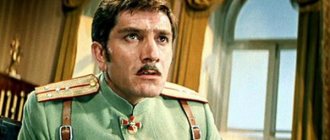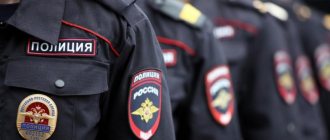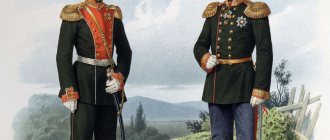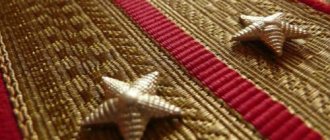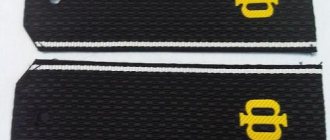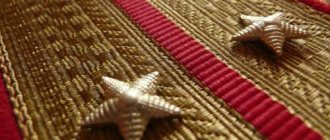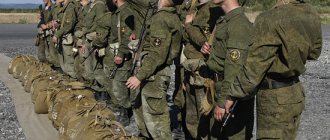The history of the origin of shoulder straps and ranks in the Armed Forces of the Russian Federation
If we look at the historical origins, then initially there were no military differences at all. For the first time in Ancient Rus', the standing army was divided into separate formations. Formations were built according to the number of people. For example, ten warriors were called "ten". The head of such a unit was called "ten's". Other formations were built on the same principle.
This system was subsequently changed several times. Under Ivan the Terrible, new units appeared. They were called "hundreds". Military ranks appeared for the first time in the Streltsy hundreds. At that time the ranks were as follows:
- Sagittarius. Compared to the modern army, this is a private.
- Foreman. In our time, this is a sergeant or sergeant major.
- Pentecostal. Now this rank would be equivalent to the rank of lieutenant.
- Centurion. The modern rank is captain.
- Head.
The following hierarchy changes were extended. New ranks have appeared:
- Soldier;
- Corporal;
- Ensign;
- Lieutenant or Lieutenant;
- Captain or captain;
- Quartermaster;
- Major;
- Lieutenant colonel;
- Colonel.
In 1654, the new rank of general was awarded for the first time. Alexander Ulyanovich Leslie was the first to receive it in Russia. He led the liberation of Smolensk. And he received this title for courage and services to the Fatherland.
What do three stripes on shoulder straps mean?
Depending on the power structure, the presence of three stripes indicates a certain rank. In the police, the Ministry of Emergency Situations and the army they have one meaning, but in the navy they have another. In order not to make a mistake, and to always know the rank of this or that person, you need to familiarize yourself with the differences that exist in the army and in the navy.
For the police and the Ministry of Emergency Situations
For employees of the Ministry of Emergency Situations and the police, the presence of three stripes on their shoulder straps indicates that the person belongs to the junior command staff. An employee of the represented government bodies with the rank of sergeant has 3 badges.
Police sergeants are awarded to people who have worked in the system for at least 2 years. Subordinate to them are representatives of the rank and file, that is, novice employees of the Ministry of Emergency Situations or the Ministry of Internal Affairs.
Shoulder straps in the Armed Forces of the Russian Federation
Shoulder straps, like military ranks, vary. Shoulder straps have a distinguishing number of criteria, such as: the color of the shoulder straps, the order of the distinctive signs on the shoulder straps themselves, the color of the distinctive signs.
Another criterion is the uniform of Russian military personnel. There are three types of uniforms in the army, namely: casual, field and dress.
On the everyday uniform of non-officer Russian military personnel there are shoulder straps with two narrow stripes along the edges of the longitudinal part of the shoulder strap.
On the uniform of officers of Russian military personnel there are three more types of shoulder straps for everyday uniforms:
- Shoulder straps for junior officers of the Russian army: have one stripe located in the center along the shoulder strap itself.
- Senior officers of the Russian army: wear shoulder straps with two longitudinal stripes located in the center of the shoulder strap.
- The shoulder straps of senior officers of the Russian army have a fabric relief along the entire shoulder strap. The edges of the shoulder strap are framed by a narrow stripe. The stars follow strictly in one row.
- The Marshal of the Russian Federation has shoulder straps with fabric relief and they are distinguished by their gold color.
The field uniform of Russian military personnel requires wearing different shoulder straps. Consider these shoulder straps:
- The shoulder straps of non-officers of the Russian army are a regular rectangle, camouflaged in the color of the summer taiga with a longitudinal stripe.
- The field uniform of junior officers of the Russian army requires wearing shoulder straps with relatively small dark green stars.
- Senior officers of the Russian army wear shoulder straps on their field uniforms with large stars.
- The senior officers of the Russian army have identical shoulder straps with stars located strictly in one row.
- The General of the Army and Marshal of the Russian Federation have shoulder straps with large gold stars.
What do stripes on shoulder straps mean?
Stripes are often called “straps”. This is a slang designation for the distinctive insignia that is worn on the shoulder straps of law enforcement officers. A military man may have one, two or three stripes. They differ in size and location.
If a serviceman in the RF Armed Forces has one badge, then his rank is corporal. Two - junior sergeant. Three - sergeant. One wide one is a senior sergeant and one wide vertical one is a sergeant major. In the navy and police, the gradation of ranks is slightly different. Next, let's try to figure out what the differences are.
Police insignia 2011 and 2014
In 2011, the longitudinal centerline of the police general's shoulder strap was equipped with four stars and a red edging. The embroidered stars had a diameter of 22 mm. In 2014, the size of the stars increased to 4 cm. The red edging remained the same.
Often on general’s shoulder straps you can find the tag of the FSUE “43 TsEPK” of the RF Ministry of Defense - the oldest Moscow enterprise engaged in individual tailoring of uniforms for senior officers.
The linear products of this enterprise are still used today by generals of the Ministry of Internal Affairs, the Federal Security Service, the Federal Security Service, the prosecutor's office and the Ministry of Emergency Situations of Russia.
Ensign
Despite the fact that a lieutenant already belongs to the officer corps, he is still listed as belonging to the middle ranks, because this is only the first step on the path to higher ranks.
Externally, shoulder straps ml. lieutenant are significantly different from those who were with him in the rank of senior sergeant. However, as soon as such a promotion occurs, the army or police officer immediately receives shoulder straps , on which there are larger stars, and the external design of the shoulder insignia is somewhat different.
A senior sergeant the shoulder straps of a junior lieutenant if he has demonstrated exemplary behavior. If he approached the assignments entrusted to him with full responsibility, and also made competent decisions, then a promotion in rank could come to him after just a year.
Lieutenant shoulder straps are worn by a serviceman promoted to rank for the next two years. During this time, he must prove that he is worthy of promotion to the next level.
The characteristics shoulder straps are as follows:
- since this is only the first step, there is no talk of how many stars are on the shoulder straps of a junior lieutenant, since only one star comes with a new rank of a higher rank;
- the size of the star on the shoulder straps of this rank is 1.3 cm in diameter;
- the distance on the junior lieutenant's shoulder straps, starting from the very edge of the shoulder distinctive element and ending with the center of the first (and in this case, the only) star is 4.5 cm;
- the distance from the center of one star to the center of another is not established in this case due to the presence of only one star.
The shoulder straps of a junior lieutenant also differ in external features, since from edge to edge of the shoulder straps there is a red line, called a clearance in military circles, strictly in the center.
Symbols on the shoulder straps of middle, senior and senior personnel
All commanding officers, except the junior ones, completely lack stripes, but instead of them, the shoulder straps are decorated with thin stripes of red color (gaps). They are located horizontally, their number depends on the rank. The exception is senior management. There are no such stripes on their shoulder straps; only a red edging around the perimeter of the shoulder badge remains, as well as on the shoulder badges of all other members of the structure.
So the average composition:
- A junior police lieutenant wears one small star over a red blaze.
- The police lieutenant has two small stars placed vertically on the edge of the shoulder strap, separated by the same red stripe.
- Senior police lieutenant. His insignia is a single stripe, three small stars placed in a triangle on the edge .
- The police captain already wears four small stars, one pair of them is located vertically, and the other is horizontal, without intersecting.
The shoulder straps of senior personnel are distinguished by the presence of a pair of parallel gaps.
- The Police Major has one middle star in the middle of the stripes.
- The police lieutenant colonel has two middle stars placed on the stripes on the edge of the shoulder strap.
- The police colonel already has a triangle of three medium-sized stars .
The higher composition does not have stripes and stripes; the stars on the shoulder insignia are large.
- Major General of Police. His shoulder straps are decorated with one large star.
- Lieutenant General of Police. On his shoulders are two stars placed horizontally.
- The Colonel General of Police has, accordingly, three stars located horizontally .
- The Russian Police General has four stars, also located horizontally
When were shoulder straps introduced?
In the history of Russia, shoulder straps began to be used during the reign of Peter I. Initially, they were intended only for soldiers. Over time, officers began to use them. Since there was no single sample of shoulder straps, they performed the distinguishing function poorly. This was corrected by introducing uniforms of different colors: each battalion or regiment had its own color scheme. Officer's shoulder straps had a hexagonal shape, and soldiers' shoulder straps had a pentagonal shape. General's shoulder straps in those days were gold or silver braid without stars. Similar insignia were used until 1917.
After the October Revolution, soldiers' and generals' shoulder straps were abolished, since they were perceived in Soviet Russia as hostile. They were preserved by the White Guards. The insignia became a counter-revolutionary symbol, and the officers wearing them were called “golden chasers.” This situation persisted until the very beginning of the Great Patriotic War.
Lieutenant
After a serviceman or representative of law enforcement agencies has served in the rank of junior lieutenant for two years and shown himself in the best possible light, he is promoted to the rank of lieutenant. This is a related title, but it carries greater responsibility and covers a larger scope of responsibilities to management.
Accordingly, a soldier must also serve in this rank for several years in order to prove to his superiors that he is able to cope with more complex work. If he does not have any negative situations that could tarnish his military honor, then after a while he is promoted to the rank of senior lieutenant, the highest rank in his category.
The characteristics of shoulder straps include the following:
- speaking about how many stars a lieutenant has on his shoulder straps, one can follow the logic that this rank is one rank higher than the previous one, therefore, the number of stars increases to two;
- the distance of the stars on the shoulder straps from their edge to the centers of both stars (since they are at the same distance from each other) is reduced by almost half and amounts to 2.5 cm;
- if the only star that a junior lieutenant is located strictly on the central red line, then the lieutenant’s two stars are located on the sides of the central clear;
- there is no information about what the distance between the stars on the lieutenant’s shoulder straps should be, since usually in the army or law enforcement agencies a measurement is made along the shoulder straps , but in this case the stars are placed on the lieutenant’s shoulder straps at the same distance in relation to each other;
- the diameter of each star is the same as that of the junior lieutenant, that is, the same 1.3 cm.
Two stars for the military
Among the military personnel of the Russian army, distinctive insignia in the form of two stars are reserved for persons with similar ranks. The color of the shoulder strap can be considered a significant difference. So, if among the employees of the Ministry of Internal Affairs the shoulder straps are predominantly blue, then among the military they are brown-green or with a protective spotted pattern. Also, the military ensign’s stripes are located slightly differently than those of his colleague from the Ministry of Internal Affairs: along the edge along the shoulder strap. Among senior officers, in particular lieutenant generals (in the Navy - vice admirals), stars are stripes on their shoulder straps.
Stars first appeared on military uniforms in Russia in the 20s of the 19th century. At that time, one star was worn by warrant officers, two stars by majors, three by lieutenant colonels, and four by staff captains.
Where should shoulder straps be placed on military personnel's clothing?
As a rule, shoulder straps are sewn onto clothing on the shoulders. Depending on whether a serviceman is attending a ceremonial event, or whether it is an everyday uniform of the shoulder straps also differs . On special occasions they have a gilded base and variegated edging. The color depends on the branch of the military to which the soldier belongs.
Shoulder straps are attached not only to outerwear, that is, to jackets, but also to shirts. If it comes to winter time, then shoulder straps are also attached to military winter coats . In addition, the appearance is complemented by special headdresses.
It should also be noted that the shoulder distinctive elements themselves can be either tightly sewn to the clothing or removable. It is recommended that the serviceman keep a few extra stars in reserve, the same as on his shoulder straps, since in the field they can accidentally fly off the shoulder straps .
